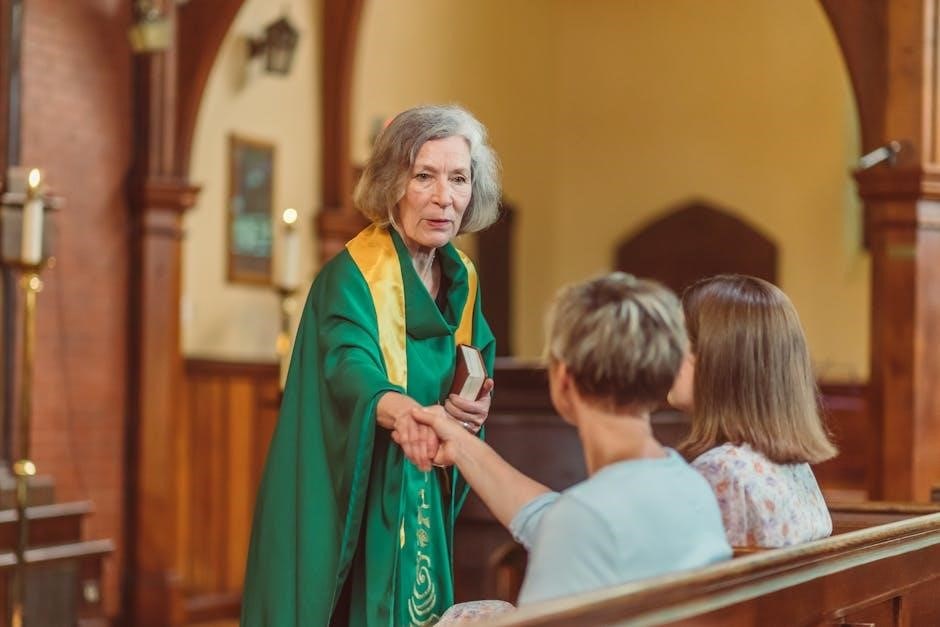
The Catholic Tenebrae Service is a solemn observance of Jesus’ passion and death, typically held on Good Friday, with a focus on chanting and extinguishing candles in a somber atmosphere always․
Definition and Meaning of Tenebrae
The term Tenebrae is derived from the Latin word for darkness or shadows, and it can also be translated as night or death․ This definition is closely tied to the themes of the service, which remembers Jesus’ suffering and death․ The use of the Latin word Tenebrae emphasizes the somber and solemn nature of the service․ In the context of the Catholic Church, Tenebrae refers to a specific type of service that is held on Good Friday, which is a day of mourning and reflection․ The definition of Tenebrae is rooted in the church’s tradition and history, and it continues to be an important part of Catholic liturgy and worship․ The meaning of Tenebrae is multifaceted, encompassing not only the physical darkness of the extinguished candles but also the emotional and spiritual darkness of Jesus’ passion and death․ The service is a powerful reminder of the significance of Jesus’ sacrifice and the importance of faith and devotion․ The Tenebrae service is a unique and meaningful experience for participants, offering a time for reflection, prayer, and contemplation․

History and Origins of the Tenebrae Service
The Tenebrae service has ancient Christian roots and origins dating back centuries with historical significance always․
Latin Word for Darkness and Shadows
The Latin word for darkness and shadows is a term that holds significant meaning in the context of the Tenebrae service, which is a solemn observance of Jesus’ passion and death․
The word is derived from the Latin language and is used to describe the somber and introspective atmosphere of the service․
In the Tenebrae service, the Latin word for darkness and shadows is used to create a sense of reverence and contemplation, inviting participants to reflect on the significance of Jesus’ sacrifice․
The use of this word adds to the overall sense of solemnity and gravitas, making the Tenebrae service a powerful and moving experience for all who participate․
The Latin word for darkness and shadows is an integral part of the Tenebrae service, and its meaning and significance are deeply rooted in the history and tradition of the service․
The word is a reminder of the importance of faith and devotion, and its use in the Tenebrae service serves as a powerful reminder of the enduring power of faith and tradition․

Components of the Tenebrae Service
Chanting, readings, and candle extinguishing are key components of the Tenebrae service always used․
Extinguishing of Candles and Chanting of Lamentations
The extinguishing of candles is a significant element of the Tenebrae service, symbolizing the darkness and despair of Jesus’ death․
During the service, candles are extinguished one by one, plunging the church into darkness, while the choir chants lamentations from the prophet Jeremiah․
The chanting of lamentations is a traditional part of the Tenebrae service, with the choir singing responsories and polyphonic settings, creating a somber and reflective atmosphere․
The extinguishing of candles and chanting of lamentations work together to create a powerful and moving experience, helping worshippers to reflect on Jesus’ suffering and death․
The service is a time for contemplation and prayer, with the darkness and music combining to create a sense of sorrow and loss, and the chanting of lamentations adds to the emotional impact of the service․

Significance of the Tenebrae Service in the Catholic Church
The Tenebrae service holds great significance, remembering Jesus’ suffering and death, and preparing for Easter, with solemn music and prayer, in a traditional Catholic setting always used․
Remembering Jesus’ Suffering and Death
The Tenebrae service is a solemn occasion that remembers Jesus’ suffering and death, with a focus on the events leading up to his crucifixion․ The service typically includes the chanting of lamentations and responsories, which reflect on the darkness and sorrow of Jesus’ passion․ The progressive extinguishing of candles during the service symbolizes the increasing darkness and despair that surrounded Jesus as he approached his death․ The service also includes readings from the prophets and the New Testament, which provide a historical and theological context for Jesus’ suffering and death․ Through the Tenebrae service, Catholics are able to reflect on the significance of Jesus’ sacrifice and prepare for the joy and celebration of Easter․ Additionally, the service provides an opportunity for Catholics to come together and support one another in their faith, and to renew their commitment to following Jesus’ teachings․ The service is an important part of the Catholic liturgical calendar․

Tenebrae Service on Good Friday
The Tenebrae service is held on Good Friday evening, typically at seven-thirty, with a solemn atmosphere and progressive candle extinguishing, symbolizing Jesus’ final hours always slowly․
Progressive Extinguishing of Candles and Darkness
The progressive extinguishing of candles is a pivotal element of the Tenebrae service, symbolizing the gradual darkness that fell upon the world as Jesus approached his death․
The candles are extinguished one by one, plunging the church into an increasing darkness, representative of the spiritual darkness that Jesus endured on the cross․
This somber and powerful ritual is a poignant reminder of the sacrifices that Jesus made for humanity, and the darkness that he faced in his final hours․
The extinguishing of the candles also serves as a reminder of the temporary nature of earthly life and the inevitability of death, prompting worshippers to reflect on their own mortality and the importance of living a virtuous life․
As the last candle is extinguished, the church is plunged into total darkness, symbolizing the darkness of Jesus’ tomb and the hope of his resurrection․
The progressive extinguishing of candles and darkness is a unique and moving aspect of the Tenebrae service, inviting worshippers to contemplate the depths of Jesus’ suffering and the significance of his sacrifice․
Office of Tenebrae and Chanting of Responsories
The Office of Tenebrae features chanting of responsories and lamentations in a traditional setting always sung by the cathedral schola with great devotion and harmony․
Traditional Settings by the Cathedral Schola
The cathedral schola plays a vital role in the Tenebrae service, presenting traditional settings of the responsories and lamentations with great musicality and devotion․
The schola’s chanting is a key element of the service, adding to the overall somber and reflective atmosphere․
The traditional settings used by the schola are often polyphonic, featuring complex harmonies and interweaving vocal lines․
This style of music is particularly well-suited to the Tenebrae service, as it creates a sense of tension and drama․
The schola’s performance is always highly anticipated, and their traditional settings are a major part of the service’s appeal․
The use of traditional settings also helps to create a sense of continuity with the past, connecting the congregation to the long history of the Tenebrae service․
Overall, the cathedral schola’s traditional settings are an essential part of the Tenebrae service, and help to make it a unique and unforgettable experience․
The schola’s music is a perfect complement to the service’s themes of darkness and light, and helps to create a sense of emotional depth and resonance․
The traditional settings used by the schola are a key element of the service’s overall impact, and help to make it a truly memorable experience․
Tenebrae Service and Catholic Easter Vigil Mass
The Tenebrae service is often closely tied to the Catholic Easter Vigil Mass, which takes place on the evening of Holy Saturday․
The two services are connected by their shared themes of darkness and light, and the Tenebrae service can be seen as a preparation for the Easter Vigil․
The Easter Vigil Mass is a time of great joy and celebration, as it marks the resurrection of Jesus and the beginning of the Easter season․
In contrast, the Tenebrae service is a more somber and reflective occasion, focusing on the passion and death of Jesus․
Despite these differences, the two services are closely linked, and the Tenebrae service can be seen as a necessary precursor to the Easter Vigil․
The Tenebrae service helps to create a sense of anticipation and expectation, which is then fulfilled in the Easter Vigil Mass․
The combination of the two services creates a powerful and moving experience, and helps to deepen the participant’s understanding of the Easter story․
The connection between the Tenebrae service and the Easter Vigil Mass is an important part of the Catholic liturgical calendar․